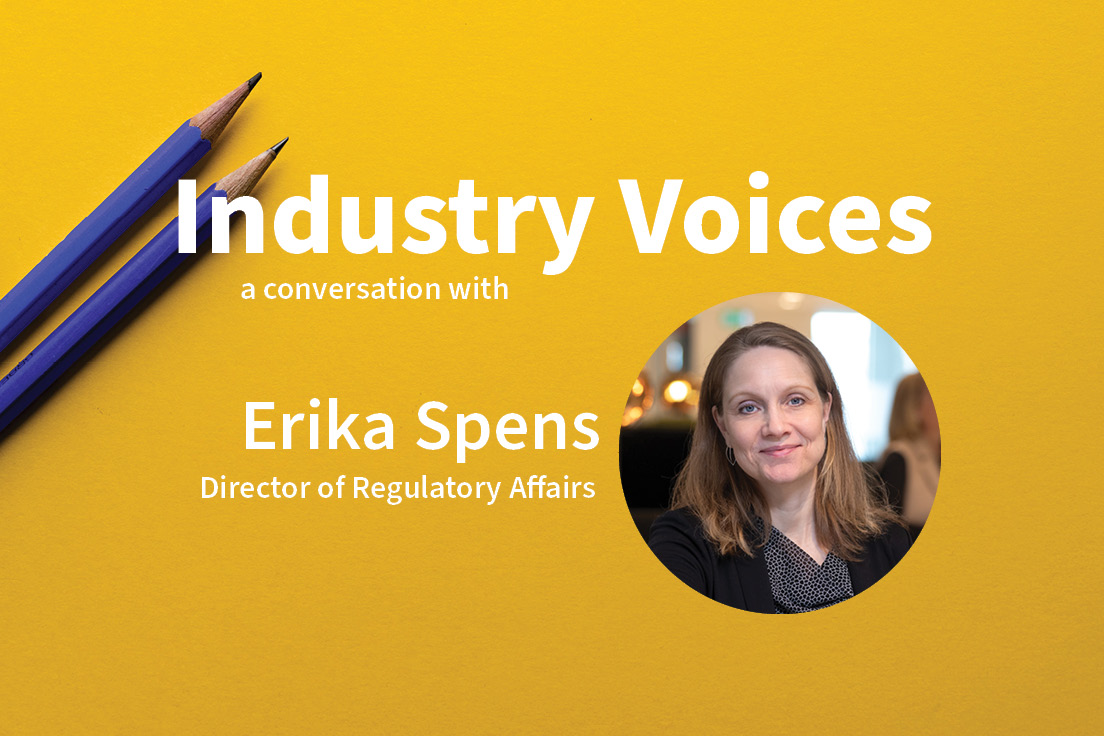Erika Spens on Developing Your Regulatory Strategy


During drug development, a comprehensive regulatory strategy is key for saving time and money. There are many common mistakes drug developers make that can be avoided if they consider their regulatory strategy and adapt it over time. For this edition of Industry Voices, Erika Spens, Director of Regulatory Affairs at Cytel, shares her expert insight on shaping a regulatory strategy, its many benefits, and how various factors affect the road toward market authorization.
To begin, what are we talking about when we say regulatory affairs or regulatory strategy?
Regulatory affairs as a profession emerged from government need to protect public health by ensuring that products intended for human use are safe and efficacious. The company is responsible for ensuring that products are developed according to applicable laws and guidelines. This is a huge task and requires dedicated personnel who focus on understanding the current regulatory landscape in the countries or regions of interest.
During development, the purpose of the regulatory strategy is to get the product approved and commercialized as soon as possible in the most cost-efficient way, without compromising the safety and efficacy evidence generation. For authorized products, the purpose is to keep them compliant and preferably increase commercial value by adding additional data.
What should a developer consider within their regulatory strategy?
A regulatory strategy defines the road to market authorization. It includes the proposed categorization of the product, the legal path for market authorization and an assessment of any potential regulatory opportunities in terms of expedited or accelerated paths, and a plan for interactions with the authorities. The strategy must also include a plan for how to address the pediatric population. If your product is effective in several indications, the regulatory strategy should define the initial indication and a plan for when to add additional indications, during development or after initial approval.
So, it's an ongoing journey?
Yes, absolutely. Similar to a Target Product Profile and a Development Plan, a regulatory strategy has to be adapted as new data comes in and the world changes; new guidelines become effective or other products within the same therapeutic area are being approved. It is not possible to cover all aspects from the beginning when there are many unknowns, but if you start early, you should be able to lay out the most efficient plan and mitigate the most common mistakes. Drug development is an iterative process and developers must be prepared to continuously re-evaluate their strategy. It is dependent on the competitive landscape, both the current standard of care and upcoming new treatments.
How does the stage of development affect how sponsors craft their regulatory strategy?
Regulatory strategies are essential throughout the whole life cycle of a product. However, the nature of the regulatory questions that the strategy is meant to address changes through the development phases. During nonclinical development and Phase I/II, the primary focus is to show safety and proof of concept. As the development progresses, the regulatory roadmap becomes more important. When you have pivotal studies in sight, regulatory positioning of the product is instrumental and intertwined with the clinical development plan. All pharmaceutical products are developed in relation to other available treatment options. Ultimately, you want to know whether your product will be commercially viable. Quite often the sponsor is not planning to drive the development all the way themselves and, therefore, the focus is on the strategy up until a particular milestone. For an exit or merger, the buyer or future collaboration partner will also want to understand what additional activities are required for market approval.

Is there a significant difference in how to develop products within different therapeutic areas?
The basics are the same. Still, a significant difference exists between developing an oncology product, for example, compared to a rare disease. Well-known therapeutic indications usually have guidelines specifically applicable to that disease area that are extremely difficult to deviate from. I used to work within hemophilia, where the EMA already predefines the clinical development process for the EU.
For rare diseases, there are usually very limited or no other treatment options. For these indications and for diseases with a large unmet medical need, a smaller data set or surrogate endpoints may be conditionally accepted.
In addition to all general guidelines applicable to your product, you must be aware of existing guidelines within the specific indication or disease area where you operate.
Can you elaborate on how the type of product you are hoping to market can fundamentally change your regulatory strategy?
There are different types of drug modalities: chemical molecules, antibodies, vaccines, peptides, nucleotides, cell-based products, devices, and so forth. Depending on the modality, the product would fall into different regulatory categories with different regulatory requirements. In most cases, it’s relatively straightforward which category your product would fall into, but not always. There are borderline products where you must go deep into the guidelines and have a dialogue with the regulatory bodies to align on a regulatory classification. These borderline products may sometimes be classified differently in different regions. For example, a product may be considered a device by the FDA and a pharma product by the EMA. In such situations, you must adapt your development to meet both the device and pharma regulations.
Many developers want to market their products globally. With this in mind, and the differences that may be at play in different regions, what do developers need to consider?
Most developers build their regulatory strategy based on the regulatory requirements from the FDA and EMA. Other countries or regions may have specific requirements, but in general, a product developed for the US and EU could expand to additional markets even though some complementary activities or studies may be required.
As soon as you know there is a commercial interest to go into a particular country or region, it should be included in your strategy. The earlier you start, the higher the likelihood of success. Certain Asian markets like Japan and China have very specific requirements for native patients and clinical studies performed in the local setting, which is important to be aware of early. Developing countries usually demand prior approval in the US or EU. The focus for market authorization in these counties is on the manufacturing process and the supply chain.
It is important to note that it is not only the data requirement itself that may differ between regions. The technical requirement and documentation supporting the data may also vary. This is important to consider during the due diligence process preceding acquisitions. The development history may be long and involve several previous acquisitions or mergers.

Scientific advice meetings with regulatory agencies are an essential part of the regulatory process. What advice can you give to developers planning these meetings?
The purpose of having interactions with the authorities is to receive guidance. Discovering too late that data is missing can be detrimental to the project. Equally, performing studies that are not needed is unethical and costs money that could have been used for other activities. Sometimes I find that sponsors are reluctant to approach the authorities for fear of being misinterpreted. However, the regulatory bodies are there to help, they want products that are beneficial to the public health to reach the market successfully. Remember that the agencies have access to intelligence that is not public. Their advice generally stands on solid ground. That said, it is always possible to challenge given you present a scientifically sound justification.
It is most important to ask for guidance when the guidelines are unclear, when there are no applicable guidelines, or when you plan to deviate from the existing ones. It is also a recommendation to seek advice when the regulations differ between agencies. It’s not mandatory to have authority meetings, but it is expected. It would be foolish not to take the opportunity, especially if you are developing a novel drug.
Within the regulatory strategy you should decide which agencies to contact and when. The FDA has a relatively pre-defined process for authority interactions. In the EU, you can go for national advice to test your ideas before approaching EMA. Never ask open questions; present what you want to do, a company position describing why and on what grounds, and then ask for acceptance. The company’s position should be data-driven and refer to applicable guidelines.
Sometimes, you receive an answer you did not want to have. If the question was not appropriately phrased, the response may be unclear or inconclusive. The response stays with the product, but there is always a possibility to justify why things should be done differently given a solid argumentation. The alternative of not knowing the agency’s views of your product development is much worse, considering the time and costs invested.
It sounds like there are many benefits to having a solid regulatory strategy — it is a cost saver, a time saver, it will hopefully get your product approved, and continue its compliance. Any additional benefits that developers should be aware of?
The regulatory strategy is an excellent business tool. If you are in dialogue with investors or potential collaboration partners, it creates significant value to be able to present a comprehensive regulatory roadmap showing what regulatory routes and opportunities are relevant to your product, which regulatory milestones you expect to reach, and when.
Thank you, Erika, for your insight!
Interested in learning more? Contact us!

About Erika Spens
Erika Spens, PhD, is Director of Regulatory Affairs at Cytel. She has more than twenty years of experience within the life science industry and leads a team of regulatory affairs consultants working with small- and medium-sized companies. Her core expertise is within regulatory affairs and project management, from early development to marketing, covering a wide range of product types and therapeutic areas.
Read more from Perspectives on Enquiry & Evidence:
Sorry no results please clear the filters and try again

Drug Manufacturer Auditing: Ensuring Quality, Control, and Safety

Guidelines Are Not Instruction Manuals: Customize Your Way to First-in-Human Clinical Trials



